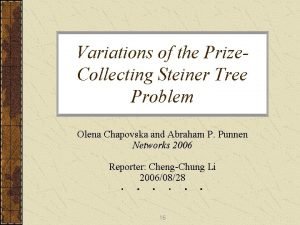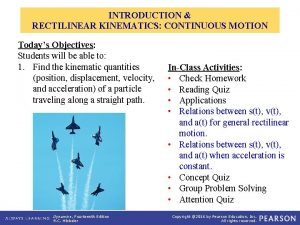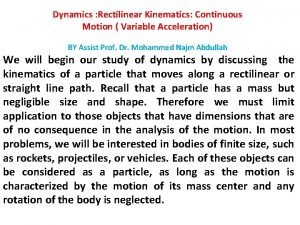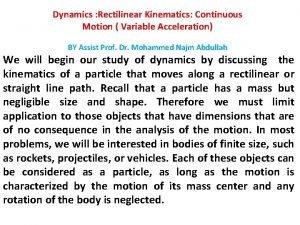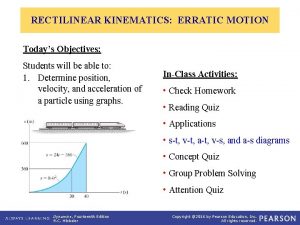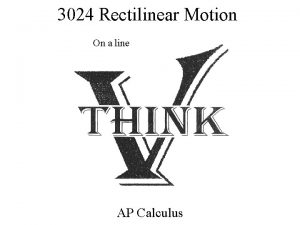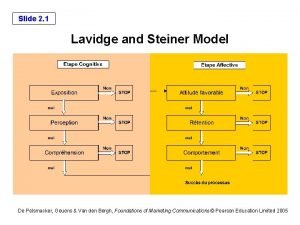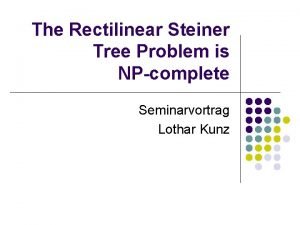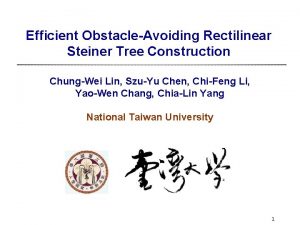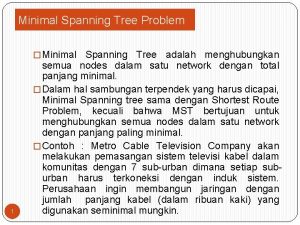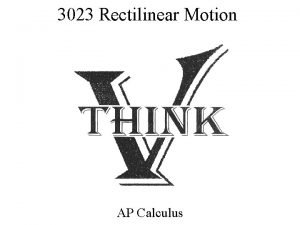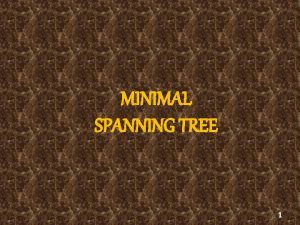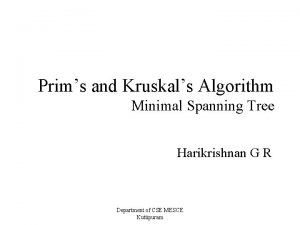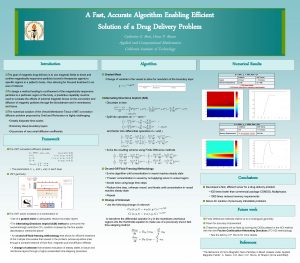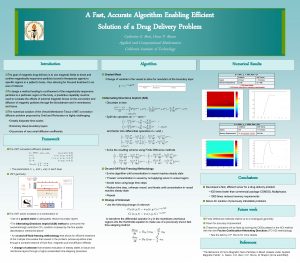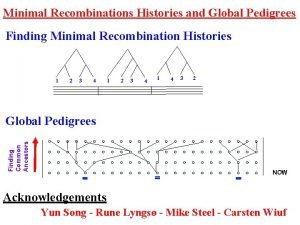Fast and Accurate Rectilinear Steiner Minimal Tree Algorithm

























- Slides: 25

Fast and Accurate Rectilinear Steiner Minimal Tree Algorithm for VLSI Design Chris Chu Iowa State University Yiu-Chung Wong Rio Design Automation

RSMT Problem n Rectilinear Steiner minimal tree (RSMT) problem: n n n Optimal algorithms: n n Griffith et al. [TCAD 94] Batched 1 -Steiner heuristic (BI 1 S) Mandoiu, Vazirani, Ganley [ICCAD-99] Low-complexity algorithms: n n n Hwang, Richards, Winter [ADM 92] Warme, Winter, Zachariasen [AST 00] Geo. Steiner package Near-optimal algorithms: n n Given pin positions, find a rectilinear Steiner tree with minimum WL NP-complete Borah, Owens, Irwin [TCAD 94] Edge-based heuristic, O(n log n) Zhou [ISPD 03] Spanning graph based, O(n log n) Algorithms targeting low-degree nets (VLSI applications): n n Soukup [Proc. IEEE 81] Single Trunk Steiner Tree (STST) Chen et al. [SLIP 02] Refined Single Trunk Tree (RST-T) 2

Overview n A fast and accurate algorithm targeting VLSI applications Based on the FLUTE (Fast Look. Up Table Estimation) idea [ICCAD-04] with three new contributions The new algorithm is still called FLUTE n Handling of low degree nets is extremely well: n n n Optimal and extremely efficient for nets up to 9 pins Still very accurate for nets up to degree 100 So FLUTE is especially suitable for VLSI applications: n Over all 1. 57 million nets in 18 IBM circuits [ISPD 98] n More accurate than Batched 1 -Steiner heuristic n Almost as fast as minimum spanning tree construction 3

Review of FLUTE n n n Lookup Table based approach Originally proposed for wirelength estimation Given a net: 2 1. Find the group index of the net 1 4 3 Group index: 3142 2. Get the POWVs from LUT POWVs: (1, 2, 1, 1) (1, 1, 2, 1) 3. Find the segment lengths 2 6 2 3 2 5 4. Find WL for each POWV and return the best 3 2 5 HPWL + 2 = 22 HPWL + 6 = 26 Return 4

Statistics on POWV Table n Boundary compaction technique to build LUT n n Optimal up to degree 9 Table size for all nets up to degree 9 is 2. 75 MB MST-based algorithm to evaluate a net efficiently Impractical for high-degree nets 5

High-Degree Nets by Net Breaking n Build lookup table only up to degree D=9 n n n For nets up to degree D, use lookup table For nets with degree > D, recursively break net until degree <= D Original Net Breaking Technique: n n Try to break a net both horizontally and vertically For each direction, select one pin to break the net n Select the pin that minimize total HPWL of two subnets 6

Our Contributions 1. Extension for RSMT construction 2. Improved net breaking technique n n Optimal net breaking algorithm Net Breaking Heuristic #1 Net Breaking Heuristic #2 Net Breaking Heuristic #3 3. Accuracy control scheme 7

RSMT Construction n If degree <= D, store 1 routing topology for each POWV (1, 2, 1, 1) POWV (1, 1, 2, 1) n If degree > D, Steiner trees of two sub-nets are combined n Redundant segment can be detected and removed 8

Optimal Net Breaking Algorithm Condition: Pins on opposite quadrants. Theorem: By combining the two optimal sub-trees, the Steiner tree constructed is optimal. Steiner node 9

Net Breaking Heuristic #1 n n A score for each direction and each pin Break in a way which gives the highest score Subnet 1 Pin r Subnet 2 10

Net Breaking Heuristic #2 n n A score for each direction and each pin Break in a way which gives the highest score Subnet 1 Pin r Subnet 2 11

Net Breaking Heuristic #3 n n A score for each direction and each pin Break in a way which gives the highest score Center grid point Pin r 12

Accuracy Control Scheme n n n Accuracy parameter A Break a net in A ways with the highest scores Subnets are handled with accuracy max(A-1, 1 ) Runtime complexity = O(A! n log n) Default A=3 3 1 1 2 1 13

Experimental Setup n Comparing five techniques: n RMST – Prim’s RMST algorithm n n RST-T – Refined Single Trunk Tree n n n Zhou [ISPD 03] BI 1 S -- Batched Iterated 1 -Steiner heuristic n n Chen et al. [SLIP 02] SPAN –Spanning graph based algorithm n n Prim [BSTJ 57] Griffith et al. [TCAD 94] FLUTE with D=9 and A=3 18 IBM circuits in the ISPD 98 benchmark suite Placement by Fast. Place [ISPD 04] Optimal solutions by Geo. Steiner 3. 1 (Warme et al. ) 14

Benchmark Information 15

Accuracy Comparison 16

Runtime Comparison All experiments are carried out on a 750 MHz Sun Sparc-2 machine Normalized 17

Breakdown According to Net Degree n All 1. 57 million nets in 18 circuits 18

Accuracy vs. Runtime Tradeoff RMST Runtime (Error 4. 23%) D=9 A=1 A=2 BI 1 S Error (Runtime 8020 s) A=3 (default) A=3 A=4 A=5 A=6 A=7 19

Conclusion n FLUTE: n n n Very suitable for VLSI applications: n n n Rectilinear Steiner Minimal Tree algorithm Post-placement pre-routing wirelength estimation Optimal up to degree 9 Very accurate up to degree 100 Very fast Nice tradeoff between accuracy and runtime Techniques introduced: n n n Extension of FLUTE idea to RSMT construction 1 optimal algorithm + 3 heuristics for net breaking Scheme to tradeoff accuracy and runtime 20

Future Works n n n Better technique to handle high-degree nets RSMT construction with obstacles Extend to timing-driven Steiner tree construction « Source code available in GSRC Bookshelf: http: //vlsicad. eecs. umich. edu/BK/slots (Rectilinear Spanning and Steiner tree slot) 21

Thank You

Accuracy for Nets of Degree <=100 23

Runtime for Nets of Degree <=100 24

POWV Generation for Degree >= 7 n n Need to include some extra topologies For degree 7 or more, if all pins are on boundary, include the following topologies in addition to those generated by boundary compaction: Enumerate all POWVs for degree-7 nets Enumerate almost all POWVs for degree-8 nets 25
 Rudolf steiner franziska blie steiner
Rudolf steiner franziska blie steiner Prize collecting steiner tree
Prize collecting steiner tree Acid fast and non acid fast bacteria
Acid fast and non acid fast bacteria Acid fast vs non acid fast
Acid fast vs non acid fast Sequential minimal optimization algorithm
Sequential minimal optimization algorithm Maths questions
Maths questions Rectilinear kinematics
Rectilinear kinematics Rectilinear kinematics
Rectilinear kinematics Uniformly accelerated motion formula
Uniformly accelerated motion formula Define variable acceleration
Define variable acceleration Erratic motion
Erratic motion Uniform rectilinear movement
Uniform rectilinear movement Rectilinear motion of particles
Rectilinear motion of particles Rectilinear motion ap calculus
Rectilinear motion ap calculus Rectilinear translation
Rectilinear translation Rectilinear propagation of light
Rectilinear propagation of light Rectilinear distance example
Rectilinear distance example Lavidge y steiner
Lavidge y steiner Lavidge and steiner model
Lavidge and steiner model Ao * algorithm
Ao * algorithm Aria at steiner ranch
Aria at steiner ranch Kellerbereich
Kellerbereich Steiner’s model of group effectiveness
Steiner’s model of group effectiveness Steiner sats
Steiner sats Vahid liaghat
Vahid liaghat Dr. magdalena steiner
Dr. magdalena steiner

